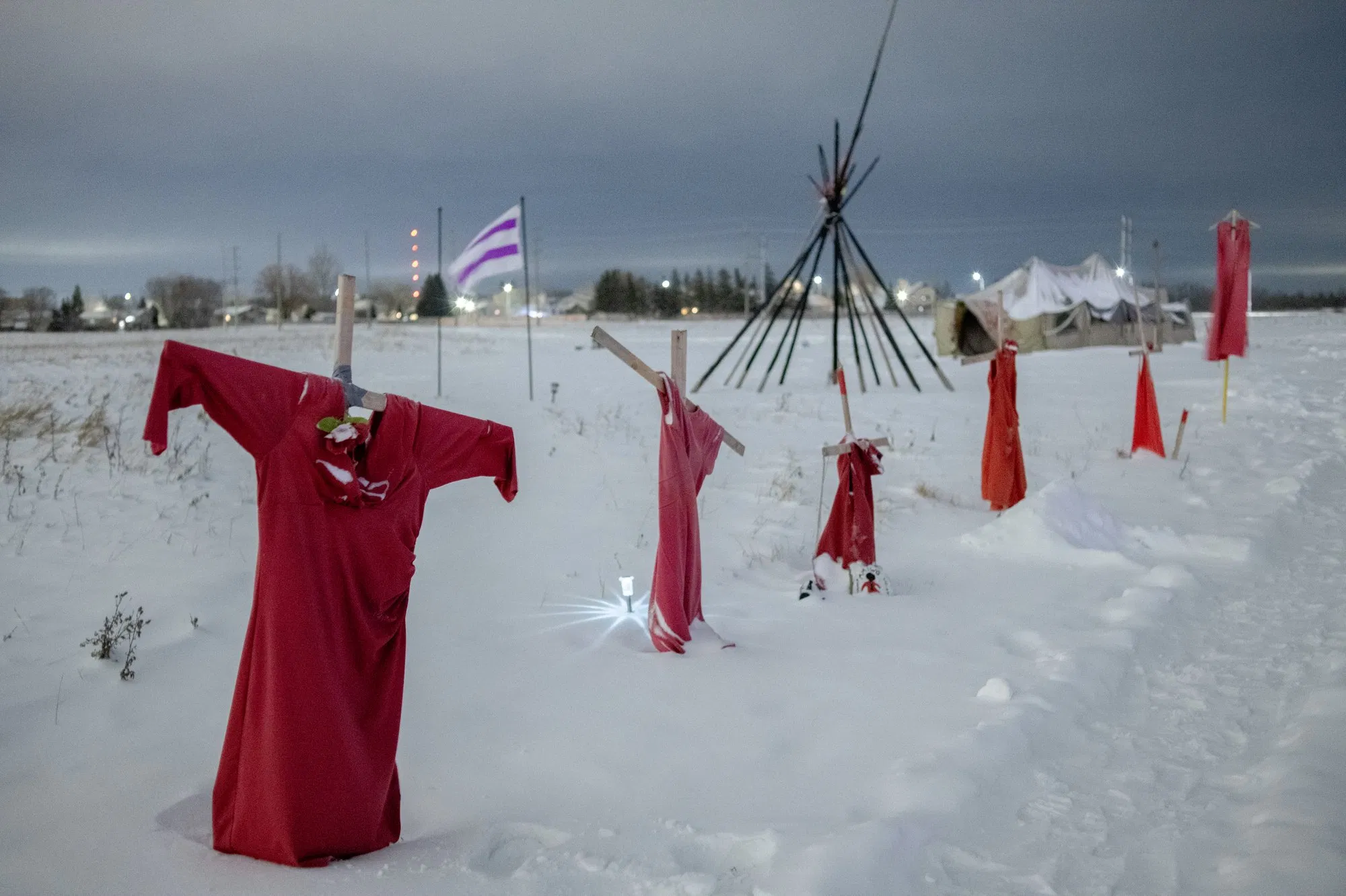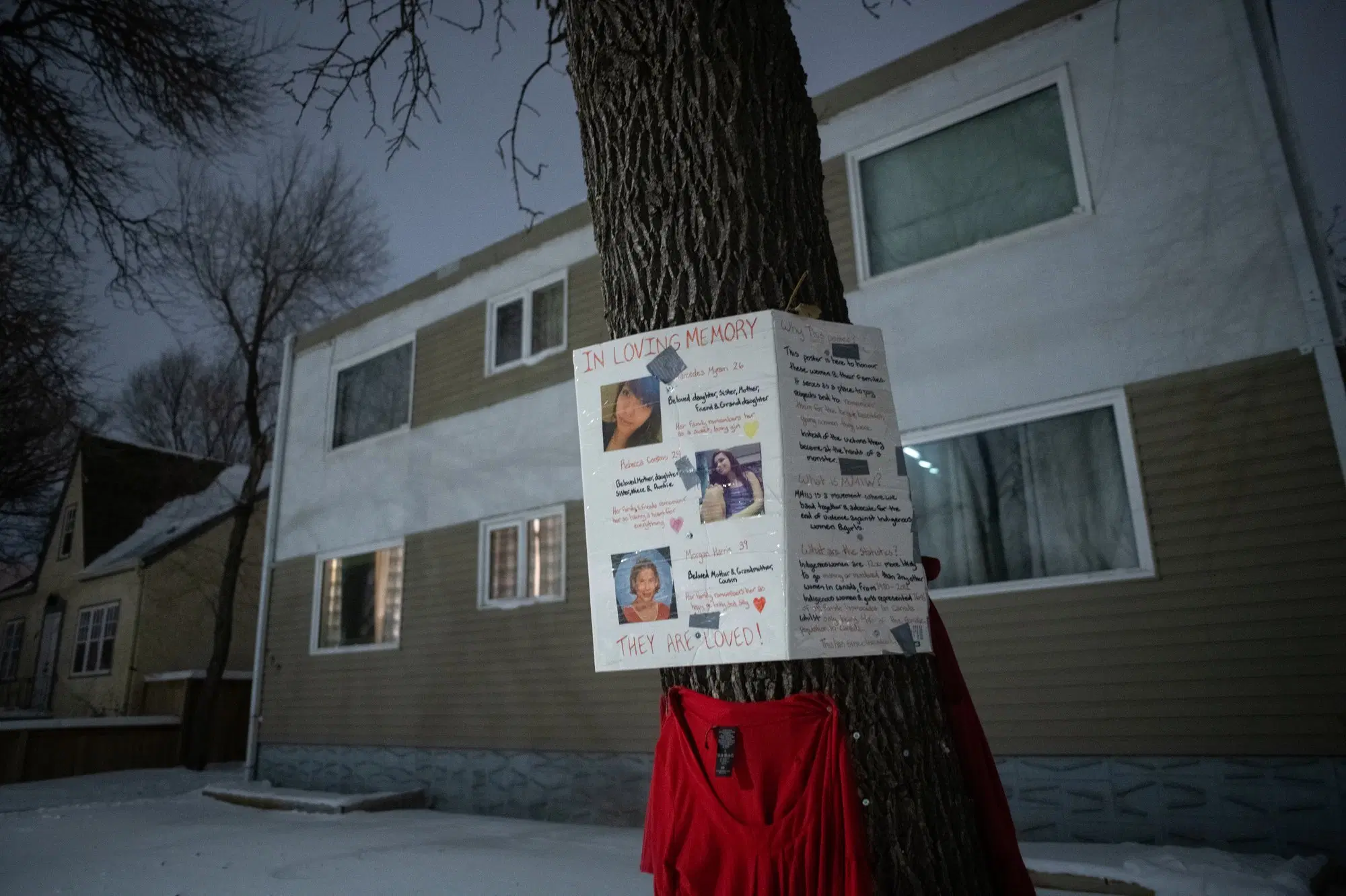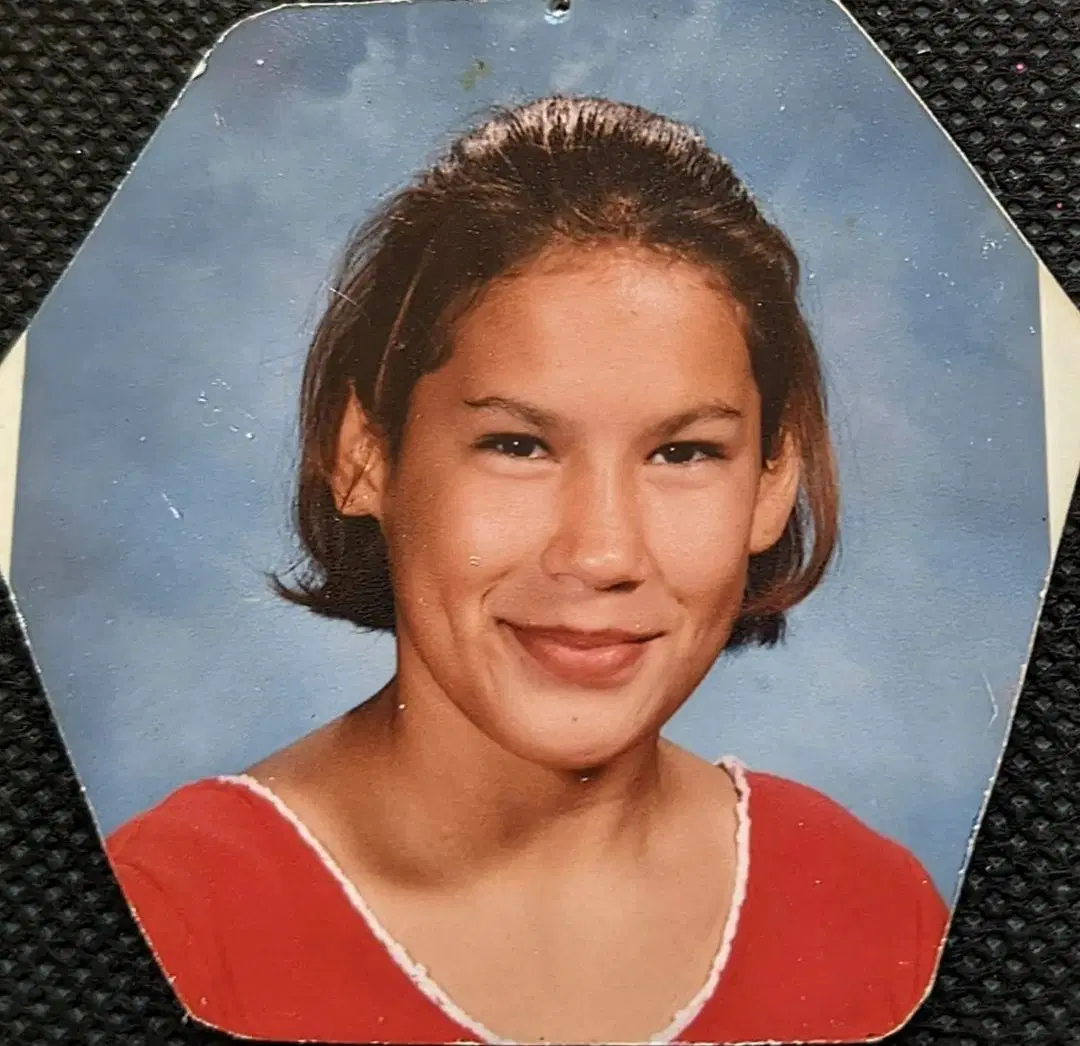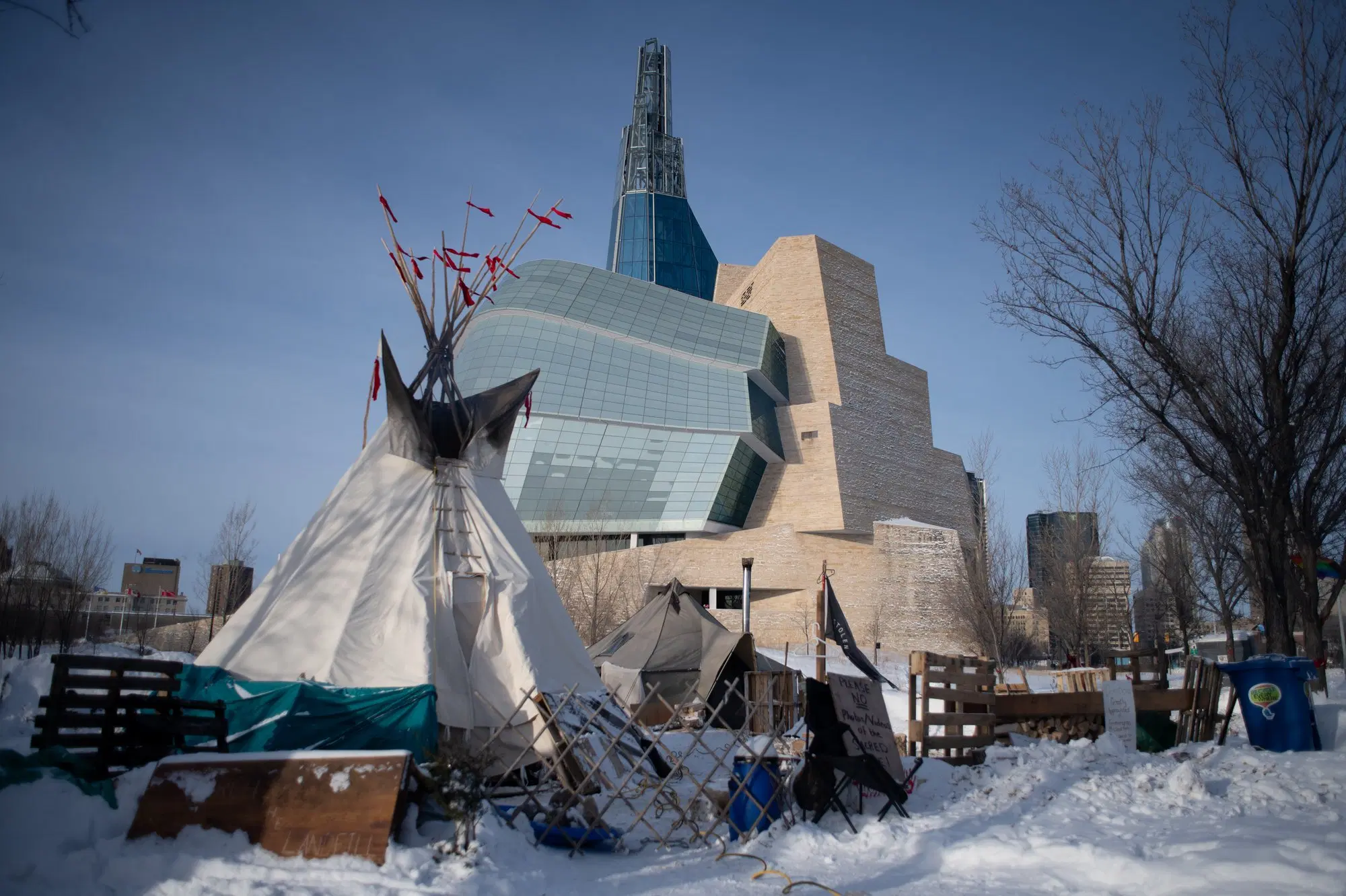A Killer Among Them
In the spring of 2022, four women went missing within the same few blocks in downtown Winnipeg. This spring, the man accused of their murders will go on trial. So will the city they all called home.

Share
February 20, 2024
They began to disappear in the winter. In February of 2022, a woman named Rebecca Contois was seen for the last time in downtown Winnipeg. Weeks later, a few blocks away, in the city’s North End, another woman, Marcedes Myran, vanished as well. Then, on the first of May, Morgan Harris was last seen near the corner of Main Street and Henry Avenue, on the borderline between downtown and the North End—though her family still doesn’t know who saw her, or who reported her missing.
Contois was 24, a mother of one. Myran was 26, with two children. Harris was 39, a mother of five and a grandmother of one. All three were Indigenous; Harris and Myran were members of Long Plain First Nation, west of Winnipeg, and Contois belonged to O-Chi-Chak-Ko-Sipi First Nation, also called Crane River. Connecting the last-known locations of each woman would triangulate an area not much larger than a few city blocks around downtown. But despite their proximity, the disappearances raised no alarms. Thousands of missing-person reports are filed with Winnipeg police annually—more than 9,300 in 2022, one of the highest rates in the country. And the neighbourhoods where Contois, Myran and Harris vanished are particularly notorious for disappearances. The women quickly faded into the background hum of the city’s day-to-day life.
One morning in mid-May of 2022, six kilometres from downtown in the neighbourhood of North Kildonan, a passerby spotted what looked like human remains in a garbage bin behind a small apartment building. Police cordoned off the scene and spent two days digging through trash before identifying the remains as belonging to Rebecca Contois. Two days later, they visited a nearby apartment rented by a 35-year-old man, Jeremy Skibicki, and charged him with her murder. News of Contois’s death was not shocking in and of itself. Winnipeg has long had one of Canada’s highest murder rates—in 2022, there were 53 murders in the city, for a rate of 6.8 per 100,000 residents. That was the second-highest rate in the nation behind Thunder Bay, and roughly triple that of Toronto, Montreal and Vancouver.
But Contois’s murder was uncommonly disturbing. First, there was its brutality. Though police haven’t revealed her cause of death, one officer called the discovery “a horrifically grisly scene.” More disturbingly, police believed that it was not an isolated act. The day after Skibicki was arrested, they executed a search warrant at his apartment. Based on what they found, they said they expected more victims to be found. If they were right, that would mean Winnipeg had its first serial killer in more than 10 years, since a man named Shawn Lamb killed at least two Indigenous women, and possibly more, in 2011 and 2012.
On a cool, grey evening a few days later, Indigenous community leaders gathered in the back lane where Contois’s partial remains were found. They lit a sacred fire and held a vigil. Days after that, police outfitted with respirators began searching the Brady Road landfill, the largest in the province, which holds five million metric tonnes of waste over nearly eight square kilometres. They found more remains on June 15, which they later confirmed also belonged to Contois. By then, a portion of the city’s Prairie Green landfill had stopped receiving garbage, to prepare for a possible landfill search. Police suspected more victims may have been left there, though this wouldn’t be publicly disclosed for months.
And then there was nothing. Spring became summer, the police investigation continued, but there was little news. The families of the missing women were haunted by the idea that Skibicki’s face was the last thing their mother, daughter, sister, had seen. And, more than a decade after a serial killer last preyed on its most vulnerable, the city was left wondering how it had happened again.
Jeremy Anthony Michael Skibicki was adopted in Winnipeg and attended the city’s Argyle Alternative High School. Former classmates there recall him as a strange figure, toweringly tall, with a head of grey hair, even as a teenager, and a deep voice. He exhibited violent tendencies early. One classmate told the Winnipeg Free Press that he seemed timid and mousy around men, but aggressive with women; another recalled him throwing her across the room during a gathering at a mutual friend’s house. (Skibicki declined to be interviewed for this story.)
Skibicki’s first encounters with the justice system were petty, including a forgery charge dating to an incident in 2008. By his mid-twenties, his behaviour was becoming violent and erratic. In 2015 he was engaged to a woman and living with her in a downtown Winnipeg apartment. She became pregnant, and during an altercation that summer, he held a knife to her stomach and threatened to kill their unborn child. A judge sentenced him to two years’ probation and prohibited him from contacting the woman, whose name is under a court-ordered publication ban. But he returned to her immediately. He told her he’d kill himself by overdosing on pills unless she took them first; she alleged that after she did and fell asleep, Skibicki sexually assaulted her. She applied for a protection order against him. Her application concluded succinctly: “He won’t stop until I’m dead.”
This was the first time Skibicki’s criminal record turned violent, and it also marked the first time he escaped consequences—his fiancée’s application was dismissed, with no reason specified. The outcome was not unusual. That same year, Manitoba courts granted 565 protection orders, but 818 applications were either denied or withdrawn.
By 2017, Skibicki had become intermittently homeless, spending much of his time downtown and in the North End and South Point Douglas. These neighbourhoods present a striking juxtaposition of grandeur and dereliction, the story of Winnipeg’s boom and bust written clearly in their bricks and mortar. In the early 1900s, Winnipeg was Canada’s third-largest city, an agricultural hub and economic powerhouse. That history is still visible today, particularly in places like the Exchange District, a national historic site filled with Victorian-era warehouses and imposing commercial buildings.
A few blocks away, the city presents a different face. The area around Main and Henry, where Morgan Harris was last seen, is in many ways a city apart, full of blank-faced warehouses and a dense concentration of shelters and social services. Nearly half of residents live below the poverty line and nearly half are Indigenous, many drawn to the city from rural and northern communities. Life expectancy in South Point Douglas, as of the 2016 census, was only 69 for men, compared to 79 citywide, and 80 nationally.
And just as the neighbourhood is a magnet for those in need, it also attracts those who prey on them: drug dealers, human traffickers and sexual predators who know that here they will be able to find both desperate people and a lack of attention from the eyes of the law. The Winnipeg Free Press said in 2020 that it was “somewhere to lock the doors and drive through, avoiding contact with ‘them.’ ”
When Skibicki started spending time in South Point Douglas, he became close with a twentysomething man named Gabriel Delorme. The pair met, says Delorme, when he was living in a tent beneath the city’s Osborne Street Bridge. He claims that Skibicki, who appears never to have held a job, mostly living on social assistance, was panhandling above for money to buy meth. Delorme bonded with Skibicki over drugs, video games and a shared love of music, especially classical—Delorme says Skibicki even played violin. They differed on religion, however. Delorme describes Skibicki as both “super Christian,” constantly quoting scripture, and “super racist,” with a special enthusiasm for anti-Semitic conspiracies.
Around 2018, Skibicki moved briefly into the King’s Motor Hotel, a tiny, since-shuttered, low-rent hotel in a desolate part of South Point Douglas, then found an apartment in the city’s west end. He took the 25-minute bus ride almost daily from his apartment to a warming space, shelter and community hub called N’Dinawemak—in English, “Our Relatives’ Place”—also in South Point Douglas.

The people who work there and in other shelters are aware that their facilities draw predators, and most staff and volunteers are trained to spot them. But bandwidth is low, staffing is short and shelters are chaotic at the best of times. Staff often have more urgent concerns than looking out for unscrupulous characters—and at first, Skibicki appeared to be simply another troublemaker. Darryl Contois (no relation to Rebecca Contois), who works in security at shelters downtown, once got into a scrape with Skibicki. “He was harassing a woman, trying to take her home,” he says. She was attempting to get away from him, and Contois stepped in to back her up. Skibicki left after the police showed up—but not before claiming to be a white supremacist.
He often visited the Siloam Mission, a Christian non-profit on Princess Street, for hot meals. There, he would ply women with promises of drugs and—when he was housed—a hot shower at his place. That’s how, on a frigid evening in February of 2018, he met Diane.
Diane is a Métis woman whose real name is under a court-ordered publication ban. When she met Skibicki, she’d been living on the streets, struggling with an intense addiction to meth. At the Siloam Mission that night, she was waiting for a bed to open up. She remembers that Skibicki approached her, and she thought he seemed sweet and charming. He introduced himself as David Plissken, a riff on Snake Plissken, the anti-hero from the film Escape From New York. He invited her back to his place. She knew it was a risk, but the prospect of warmth, a shower and a comfortable bed in a private apartment was too good to pass up—as was a chance to get high. They left together.
The relationship moved fast through the rest of the winter and into spring, fuelled by meth and a toxic co-dependency. Desperate for companionship, seeking refuge from the loneliness of life on the streets, Diane put up with Skibicki’s escalating angry outbursts, as well as his increasingly strange behaviour. One day in July, at a pharmacy, Skibicki suddenly raised his voice and announced, “Can I get everyone’s attention, please?” Diane had a sinking feeling. He reassured the crowd that he wasn’t going to rob the place. Instead, he got down on one knee and proposed. Diane was embarrassed and uncertain, but she said yes.
She brought him to meet her mother, who immediately disliked him. He couldn’t look her mother in the eye, and she thought he was creepy and phony. Diane says he barely spoke to her mother, and sat glumly silent if he wasn’t in control of the conversation. Her mother encouraged Diane to break off the engagement—and then began receiving threatening phone calls purporting to be from the Proud Boys, a neo-fascist group, saying they were watching her. Diane doesn’t know if Skibicki was actually a member, but she assumes the calls came from him. She says she complained to police, and that they let him go with a warning. (Police declined interview requests for this story.)
Even if Skibicki wasn’t a Proud Boy, the association was fitting. By this point, his online persona was setting off alarm bells for old acquaintances. One high school classmate said she deleted him from Facebook due to a steady stream of white supremacist and anti-Semitic content. He posted Holocaust denials, as well as pictures of himself with an Iron Cross, the German military medal that became a Nazi symbol in the 1930s. He claimed to be an official member of “Holy Europe,” a subset of a far-right movement known as the Alliance of Patriotic Parallel Movements of European Folk, which calls for the “re-Christianization” of Europe and its former colonies. Other posts denied the existence of graves at residential schools in Canada, or insisted residential school survivors’ stories were government fabrications.
In September of 2018, Skibicki and Diane were married; the officiant performed the ceremony in her apartment. Diane was high on meth, and their two witnesses were strangers whose names she doesn’t remember. The marriage changed nothing. Skibicki grew more violent, according to Diane, fuelled by spiralling drug use.
In the summer of 2019, Gabriel Delorme—Skibicki’s friend from the Osborne Street Bridge—posted on Facebook that he was looking for somewhere to live. Skibicki offered a place in the apartment he and Diane shared. At first, they all got along and even tried to quit drugs together. But the respite was short-lived. Soon the drug use resumed, along with Skibicki’s outbursts. Delorme remembers watching Skibicki arguing with Diane over the phone one day; when he hung up, he smashed his bed frame to pieces. One night, Delorme says, Skibicki returned home sweaty and frantic, speaking erratically, asking him to have sex with Diane in front of him. “I was just playing video games, minding my own business,” says Delorme, “and he bursts in, like, ‘Hey man, are you my friend man, would you do something for me?’ ” It was the first time Delorme had seen Skibicki act so bizarrely. He refused the strange request and moved out soon after.
Skibicki and Diane’s relationship had hit its lowest point. She was constantly calling the police during his outbursts—but every time, she says, they let Skibicki go without charges. Diane says that, as he had years earlier with his previous fiancée, Skibicki repeatedly raped her while she was asleep. He sent her creepy messages via Facebook, including passages from the Bible describing male authority over women, which she believes were intended to justify his violence against her. He also said he believed in angels. “I would literally need an angel to come down to tell me to murder,” he once wrote. “I have never seen an angel, but I believe they exist.”
On their first anniversary, Diane applied for a protection order, telling the court that she feared her husband would kill her and make it look like an overdose. On the part of the application that asked if Skibicki possessed a weapon, Diane checked “yes” and wrote, “His body is a weapon.” A judge granted the order for three years. She moved out, but the pair still communicated—as devastating as the relationship had been, it was also one of her only sources of affection.
In February of 2021, says Diane, Skibicki assaulted her again, hitting her in the forehead and causing a concussion. He was charged with two counts of assault. According to Diane, the blow worsened her memory issues, which had started a couple of years earlier, after a fall. The trial was held that December. If convicted, Skibicki could have faced years in prison—but again, he escaped consequences. The charges were stayed, in part because the judge in the case deemed Diane’s testimony to be unreliable due to her memory problems. She says she told the prosecutor she believed Skibicki would end up killing someone if he walked free.
In October of 2021, Skibicki moved, far northeast of downtown, to an apartment in the neighbourhood of North Kildonan—the last place he lived before his arrest. The caretaker there began noticing a constant flow of visitors, day and night. People who used the shelter system said that in the months before his arrest, he again became a regular visitor, occasionally causing flare-ups with staff.

Police believe it was not long after this that he began to commit murder. Many serial killers have been known to target vulnerable people in neglected communities, assuming the consequences will be easier to evade. This was the approach used by Bruce McArthur, the serial killer who, between 2010 and 2017, murdered eight men, most of whom he picked up in Toronto’s gay village. Many of his victims were immigrants and refugees whose ties to the LGBTQ+ community were hidden from family and friends. The most famous example of this kind of serial killer in Canadian history is Robert Pickton, the British Columbia pig farmer who, beginning in the 1980s, picked up sex workers in Vancouver’s Downtown Eastside and brought them to his farm, where he killed them. Despite years of pleading by the families of his victims, who had vanished without a trace, it took until 2002 for police to search Pickton’s farm in Port Coquitlam, a Vancouver suburb. He was convicted of six murders, though he was charged with 26, and claimed in conversation with an undercover police officer that he’d killed 49.
According to police, Skibicki murdered his first victim in March of 2022—a woman so far unidentified, but believed to be Indigenous and in her mid-twenties. Weeks later, Gabriel Delorme, again in need of a place to stay, moved back in with him. He noticed an uptick in talk about white supremacy, and that Skibicki’s behaviour overall seemed stranger, more sinister. Delorme moved out weeks before Skibicki was arrested for the murder of Rebecca Contois.
By the time Skibicki was arrested for the murder of Rebecca Contois, Cambria Harris was already frantic with worry. No one had seen or heard from her mother, Morgan Harris, in weeks—she had been spotted downtown near Main and Henry on the first of May. Morgan had been homeless for nearly a decade, since Cambria was about 12. She had cycled through addiction treatment programs and shelters, but she’d never simply dropped out of sight for so long.
Morgan had led a difficult life, and one that only seemed to get harder as the years went on. Born in Winnipeg, she had been removed from her own mother’s home as a child and raised for years in foster care. She became pregnant with Cambria at 18, and four more siblings followed. For a while, life was good: the family lived together under the same roof, in a tidy house on Simcoe Street in Winnipeg’s West End.

One morning when Cambria was about six, she returned from a sleepover at her aunt’s house to find police cars in front of her home and garbage bags full of her family’s belongings strewn on the lawn. She suspects, though she doesn’t know for certain, that someone called in a tip to Child and Family Services about her mother’s drug use.
Cambria spent years in group and foster homes, some so chaotic and violent that she hid in her room at night. Most of the children there were Indigenous. There are about 9,000 youth in provincial and foster care in Manitoba: nearly one in 40 people under 17, the highest rate of any province. Ninety-one per cent are Indigenous.
Throughout Cambria’s teen years, she kept seeking her mother. The pair were forbidden from having unsupervised visits, but in Cambria’s words, “No one is going to tell me not to see my mother.” They would spend hours talking, walking and riding the bus along Main Street and visiting family downtown. Some relatives lived in the Manwin Hotel, a notoriously dangerous refuge of last resort on Main Street, which has been the site of at least four murders in the past six years. Sometimes, Cambria found Morgan covered in bruises. Her mother would tell her about the men—in bars, in hotels, in shelters—who propositioned her, offered her drugs for sex, beat her. “I remember once walking down Main Street, and these guys wanted to sniff us,” says Cambria. “My mom just looked and pulled me away and crossed the street.”
After Morgan disappeared in May of 2022, Cambria kept thinking about these men. When Skibicki was arrested in May, that vague figure took on specific, terrifying shape—she googled Skibicki and examined his Facebook page for clues. A few weeks after her mother vanished, Cambria joined a group called the Bear Clan—a volunteer outfit that provides security and other assistance to Indigenous people in central Winnipeg—in a search for Morgan and Marcedes Myran, another woman who had gone missing that winter. Like Morgan, she ended up on the streets after losing her children to foster care, and no one had heard from her in more than two months.

Dozens of people fanned out to shelters, hotels, bars, pawn shops, trap houses, abandoned buildings. They put up posters, often near dozens of similar signs for other missing women and girls. They looked under bridges and checked encampments along riverbanks, fabrications of sticks and tarp. Every time they came across another makeshift home, some outfitted with beds and curtains, Cambria felt a flicker of hope. Every time, it was dashed.
In September, she gave police a blood sample, to compare to the national database of missing and murdered people. In December, they called Cambria, her family and the chief of Long Plain First Nation to break the news: they believed Morgan was another of Skibicki’s alleged victims. So was Myran, they said, along with a fourth suspected victim, an as-yet unidentified woman. She was later granted, by community Elders and advocates, the honorary name Mashkode Bizhiki’ikwe, or Buffalo Woman.
One of Cambria’s siblings asked if the police had a body. The answer was no; they had only found some of Morgan’s DNA. The rest of her remains were likely at the city’s Prairie Green landfill. Then they dropped another bombshell: they had already decided not to search for bodies. If their mother was there, that’s where she would stay. According to Winnipeg police chief Danny Smyth, it would be wildly expensive and dangerous for searchers, with little probability of success. Too much time had passed, and 10,000 truckloads of garbage had since been dumped on top of where the remains were suspected to be. There would, he said, simply be no point.
A week later, Cambria and one of her sisters, Kera, were in Ottawa at a hastily organized rally on Parliament Hill, where advocates pushed for a landfill search. They met with Justin Trudeau, who promised federal funding for a feasibility study on the search (the government later provided $740,000). Weeks later, back in Winnipeg, victims’ family members set up Camp Morgan, a protest camp alongside the Trans-Canada Highway, outside the Brady Road landfill. First Nations Indigenous Warriors, a community group that patrols Winnipeg’s streets, joined them. At first, Camp Morgan was little more than a gazebo and a tarp for protection from the deep prairie freeze—temperatures that first evening dropped to 26 below zero. Within a week someone brought a tent, and the camp’s population swelled as more supporters began adding tents, sheds, stores of tools and propane.
That winter, the Assembly of Manitoba Chiefs and Long Plain First Nation gathered a team including family members, First Nations leaders, police and forensics experts to complete the feasibility study and answer the questions: how would a search be conducted? How much would it cost? Is it even possible? In May, they had an answer: yes, but it would be very, very difficult. There are no specific protocols for searching landfills; every time it’s done, searchers are reinventing the wheel.
In most modern landfills, trucks deposit garbage in cells—pits within the landfill, each about the size of a football field. Material in the cells is placed in layers, then a cap of soil is added to compress the garbage. The soil cap is then removed and more garbage is added, which over time creates a sort of geological layering, strata upon strata of compacted trash. In theory, there ought to be no more than a few weeks’ worth of garbage to sort through at Prairie Green, since the cells in question stopped receiving trash in June of 2022. But according to Emily Holland, a forensic anthropologist who contributed to the feasibility study, the cells were sloppily constructed, and some garbage may have been pushed aside or buried beneath older layers. That means much more material to search.
The most practical approach, according to the study’s authors, would begin with an excavator moving the material to a truck, which would take it to a temporary building constructed on-site. There it could be mechanically separated by size and fed to a series of conveyor belts. Metal objects would be removed by magnets. Then a team of technicians, outfitted in full protective equipment due to toxic chemicals, asbestos and other hazards, would spend shifts searching through the material as it moved slowly past them.
This is similar to the approach used on the Pickton farm, and in 2011 in Sault Ste. Marie, Ontario, when police searched a landfill for the remains of a man who was stabbed at a party and dismembered. That search took three months and cost $1 million. The Winnipeg search would be considerably harder, due to the size of the landfill and the time elapsed since the remains were likely sent there.
The feasibility study estimated it could take between six months and three and a half years, and could cost up to $184 million in public money, with no guarantee of success. But the report’s mandate transcended the technical questions at hand. It stressed that not searching would mean forcing surviving family members, and Indigenous people at large, to endure “a sacrilege.” It would also, basically, be an admission that putting bodies in the trash is an effective means of getting away with murder.

That latter point is all the more salient, as Skibicki’s alleged victims are not the first people to have ended up in Winnipeg’s landfills. In 2012, police searched the Brady Road landfill for Tanya Nepinak, a 31-year-old woman thought to have been murdered by the city’s last serial killer, Shawn Lamb. He was convicted of two other murders, but charges against him for Nepinak’s death were stayed, since her body was never found. And just last year, the remains of a 33-year-old woman named Linda Beardy were found at the Brady Road facility. Cambria wonders whether, after years of disappearances, the city’s landfills are like its rivers, which are known for turning up bodies on a semi-regular basis: unmarked graves, forgotten repositories in death for those who were consigned in life to the city’s most forgotten corners.
In September, Cambria travelled with Marcedes Myran’s family to Ottawa, Montreal and Toronto to advocate for a search. In late September, they returned home to find that the landfill search had become a flashpoint in Manitoba’s provincial election campaign. Across the city were billboards, bus-stop ads and signs, paid for by the governing Progressive Conservative party, reading “Stand firm. For health and safety reasons the answer on the landfill search just has to be no.”
Incumbent PC premier Heather Stefanson had made opposition to a search a central part of her campaign platform. She grilled NDP leader Wab Kinew during a televised debate about his vocal support for the idea, and throughout the campaign, the issue cleaved to partisan lines, with PC supporters overwhelmingly against it and NDP supporters in favour. Manitobans overall were split down the middle. But the centrality of the issue to the campaign—and the PC’s aggressive advocacy against it—baffled some observers. Speaking to the Winnipeg Free Press, University of Manitoba history professor Sean Carleton said of the PCs, “They are trying to politicize anti-Indigenous reasons as they try to motivate their base.”
If that was the strategy, it failed. In October, the NDP won the election, in part on a promise to search the landfills. Last fall, Cambria brought her then three-year-old daughter, Willow, for a meeting with Kinew, Canada’s first provincial premier of First Nations heritage. He opened the meeting with a pipe ceremony and reaffirmed his intention to proceed. Still, advocates are keeping the pressure up until a search begins. Camp Morgan is still alive, and in fact has become a semi-permanent home to a group of supporters.

When I spoke to Cambria about this, she sounded nearly overcome when discussing the way people have created a living memorial to her mother and to other women. But when the topic turned to her mother’s death, her tone took on a surprisingly hard edge. The language she chose became clear and hard; there were no polite elisions or euphemisms. She did not say Morgan “passed away.” She said, “When my mum was killed,” or “when Morgan was murdered.” It was as if anything less would soften the responsibility—not only of the killer, but of everything that placed Morgan in his path.
“It was known he had a lengthy record against his partners, a track record going back years,” said Cambria of Skibicki. “Nothing was done, over and over, cumulative failures. The justice system didn’t deal with him, the shelters didn’t deal with him.”
Beyond that, she talked about the constellation of disadvantage and difficulty that has dogged her family for generations. She pointed out the similarities between her mother’s life and her own, including their years in foster care. She talked about how, generations prior, their family fled life on their reserve due to poverty. Their ancestors ended up living in an ad hoc village in a “nuisance ground”—essentially a dump—near the town of MacGregor, west of Winnipeg. Today she describes her family’s arc in simple terms: “We’ve gone from one landfill to another.”
Skibicki is at the Milner Ridge Correctional Centre, 90 kilometres east of Winnipeg, where he’s been held since his arrest. Facing four counts of first-degree murder, he pleaded not guilty at pre-trial proceedings last November, and his trial is slated to begin in April. The case presents no shortage of complexities: as textbook as Skibicki’s methods are alleged to have been, it is rare for murder charges to be laid when there are no remains, as is the case for Morgan Harris, Marcedes Myran and Buffalo Woman. The Crown may have to rely more strongly on circumstantial evidence as a result. And there’s likely no shortage of it, circumstantial and perhaps otherwise. Skibicki’s lawyers have received about 10 terabytes of information as part of the prosecution’s disclosure process. That includes photographs and videos, says Skibicki’s lawyer, Leonard Tailleur. Some experts have suggested that Skibicki’s avowed white supremacy should be a factor in the trial, though Tailleur says that is “irrelevant.”
Buffalo Woman’s case will be even more challenging for the Crown. Pickton was initially charged with 27 murders, but was convicted on only six counts of second-degree murder. One of his suspected victims was an anonymous woman, referred to only as Jane Doe. Those charges were quashed by a judge in part due to her anonymity.
Details about the evidence presented at last fall’s pre-trial remain under a strict publication ban, but the week-long process was gruelling for families, says Cambria. It included new and disturbing revelations, and some relatives left the court in tears. Skibicki made little eye contact with anyone, and mostly kept his head down. The courtroom itself was adorned with Indigenous regalia and symbolism, including a red dress draped over a chair in the front row, to represent Buffalo Woman.
Diane did not appear, nor does she expect to be called as a witness during the trial. But Skibicki continues to exert a power over her, even from the distance of his prison cell. She can’t let go of the possibility, remote though it seems, that he may one day be free again, and what he could do to her if he is. “It’s the one thing,” she says, “that keeps me scared.”
Cambria, now 22, doesn’t feel afraid so much as haunted. She and Willow live in East Kildonan, an eight-minute drive from the apartment where Skibicki is alleged to have killed her mother. For all she knows, she says, they could have encountered one another any number of times: in line at a supermarket, passing in the street, seated side by side on the bus. For her, the fear is less of the man she will soon face in a courtroom. It is more about what may yet emerge from the same darkness that Skibicki did.
